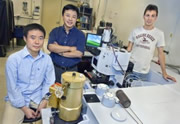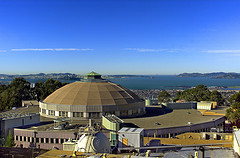


Powerful new microscopes able to resolve DNA molecules with visible light, superfast computers that use light rather than electronic signals to process information, and Harry Potteresque invisibility cloaks are just some of the many thrilling promises of transformation optics. So far transformation optics have delivered only hints as to what the future might hold, with a major roadblock being how difficult it is to modify metals at the nano or subwavelength scale.
Now a team led by Xiang Zhang (center) of the Materials Sciences Division, and including Yongmin Liu (left) and Thomas Zentgraf, has demonstrated that with only moderate modifications of a dielectric adjacent to a metal, it should be possible to achieve practical transformation optics results. Using this approach they were able to model a 180-degree bend that won’t alter the energy or properties of a light beam as it makes the U-turn, and a plasmonic version of a Luneburg lens. The team calls their approach “transformational plasmon optics” and believe it will open a new route to integrated, compact optical data-processing chips. More>
 Berkeley Lab has been named one of the top 40 U.S. institutions in the life-sciences magazine The Scientist's annual survey, “Best Places to Work in Academia.” Cited in particular for its strength in research resources and its teaching and mentoring opportunities, the Lab was ranked 35, and was the only national laboratory to make the list. The rankings were determined through analysis of responses received to a questionnaire posted on The Scientist website between September 2009 and March 2010. The 2,302 responses were from self-selected life scientists representing more than 119 institutions, including 89 from the United States and 30 from the rest of the world. See the full list here.
Berkeley Lab has been named one of the top 40 U.S. institutions in the life-sciences magazine The Scientist's annual survey, “Best Places to Work in Academia.” Cited in particular for its strength in research resources and its teaching and mentoring opportunities, the Lab was ranked 35, and was the only national laboratory to make the list. The rankings were determined through analysis of responses received to a questionnaire posted on The Scientist website between September 2009 and March 2010. The 2,302 responses were from self-selected life scientists representing more than 119 institutions, including 89 from the United States and 30 from the rest of the world. See the full list here.
![]() Organic nitrogen compounds are essential to life on Earth, but since most of these compounds are made by life itself, how did the cycle get started? Advanced Light Source users Hiroshi Imanaka and Mark Smith from the University of Arizona have found clues by modeling the atmosphere of Saturn’s largest moon, Titan, which has the only other atmosphere in our solar system that’s mostly nitrogen. Using Chemical Dynamics Beamline 9.0.2, the researchers discovered that Titan’s smog may hold the secret to the precursors of life. More>
Organic nitrogen compounds are essential to life on Earth, but since most of these compounds are made by life itself, how did the cycle get started? Advanced Light Source users Hiroshi Imanaka and Mark Smith from the University of Arizona have found clues by modeling the atmosphere of Saturn’s largest moon, Titan, which has the only other atmosphere in our solar system that’s mostly nitrogen. Using Chemical Dynamics Beamline 9.0.2, the researchers discovered that Titan’s smog may hold the secret to the precursors of life. More>
 Berkeley Lab chemist Daniel Neumark has been elected to the 2010 class of Fellows of the American Chemical Society. The 2010 ACS Fellows will be honored at a special ceremony during the ACS National Meeting in Boston on Monday, August 23. Neumark served as director of the Chemical Sciences Division from 2000 until recently; he is now chair of the UC Berkeley Chemistry Department.
Berkeley Lab chemist Daniel Neumark has been elected to the 2010 class of Fellows of the American Chemical Society. The 2010 ACS Fellows will be honored at a special ceremony during the ACS National Meeting in Boston on Monday, August 23. Neumark served as director of the Chemical Sciences Division from 2000 until recently; he is now chair of the UC Berkeley Chemistry Department.
 [BusinessWeek.com] New research suggests the combination of a memory test and a brain scan may best predict the likelihood that an individual with mild cognitive problems will go on to develop Alzheimer's disease. "Even though it's true that there aren't preventive treatments for Alzheimer's, there are good reasons to want to know early [whether you are developing it]," explained study author Susan M. Landau of the Life Sciences Division, who is also a research scientist with the Helen Wills Neuroscience Institute at UC Berkeley. Landau and her colleagues report the findings in the June 30 issue of Neurology. More>
[BusinessWeek.com] New research suggests the combination of a memory test and a brain scan may best predict the likelihood that an individual with mild cognitive problems will go on to develop Alzheimer's disease. "Even though it's true that there aren't preventive treatments for Alzheimer's, there are good reasons to want to know early [whether you are developing it]," explained study author Susan M. Landau of the Life Sciences Division, who is also a research scientist with the Helen Wills Neuroscience Institute at UC Berkeley. Landau and her colleagues report the findings in the June 30 issue of Neurology. More>
Two sessions of a new 1.5-hour class, "Introduction to Google Sites," will be offered July 6 and 8. To sign up, go to the Employee Self Service page, click on “Training Enrollment,” and sign up for BLI0951 under the computer applications category. Small project collaborations that might normally have employed eRoom may find Google Sites to be a good alternative, particularly if some of the participants are from other institutions.
Today
at Berkeley Lab encourages feedback and story ideas
Deadline for submissions is 10 a.m. two days prior to publication
TABL is produced by Public Affairs' Communications Group